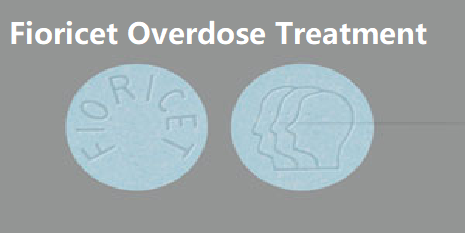Usual Adult Dose of Fioricet for Headache:

Acetaminophen 300 mg, butalbital 50 mg, and caffeine 40 mg:
1 or 2 capsule(s) orally every 4 hours as needed. Maximum daily dose: 6 doses.
Acetaminophen 325 mg, butalbital 50 mg, and caffeine 40 mg:
1 or 2 tablet(s), capsule(s), or tablespoonful(s) orally every 4 hours.
Maximum daily dose: 6 doses
Acetaminophen 500 mg, butalbital 50 mg, and caffeine 40 mg:
1 tablet or capsule orally every 4 hours.
Maximum daily dose: 6 doses
Acetaminophen 750 mg, butalbital 50 mg, and caffeine 40 mg:
1 tablet orally every 4 hours.
Maximum daily dose: 5 tablets
Usual Pediatric Dose of Fioricet for Headache:
12 years and older:
Acetaminophen 300 mg, butalbital 50 mg, and caffeine 40 mg:
1 or 2 capsule(s) orally every 4 hours as needed. Maximum daily dose: 6 doses.
Fioricet Overdose Treatment
The first signs of an acetaminophen overdose include loss of appetite, nausea, vomiting, stomach pain, sweating, and confusion or weakness. Later symptoms may include pain in your upper stomach, dark urine, and yellowing of your skin or the whites of your eyes.
Overdose symptoms may also include insomnia, restlessness, tremor, diarrhea, increased shallow breathing, uneven heartbeats, seizure (convulsions), or fainting.
An overdose of Fioricet, which contains butalbital, acetaminophen, and caffeine, can be potentially life-threatening due to the presence of butalbital and acetaminophen. If someone is suspected of overdosing on Fioricet, it’s essential to seek immediate medical attention by calling emergency services (such as 911 in the United States) or going to the nearest emergency room.
Treatment for a Fioricet overdose typically involves addressing the specific symptoms and complications that may arise. Here are some general principles of treatment:
- Stabilization: Upon arrival at the emergency room, healthcare providers will assess the individual’s vital signs and stabilize them if necessary. This may involve administering oxygen, monitoring heart rate and blood pressure, and ensuring adequate breathing.
- Activated Charcoal: In cases of recent ingestion, activated charcoal may be given to help absorb any remaining medication in the stomach and prevent further absorption into the bloodstream.
- N-acetylcysteine (NAC): If the Fioricet overdose involves acetaminophen, NAC may be administered to prevent or treat liver damage. NAC is an antidote that can help restore glutathione levels in the liver and minimize the toxic effects of acetaminophen.
- Supportive Care: Supportive care may be provided to manage symptoms such as nausea, vomiting, and agitation. Intravenous fluids may be given to maintain hydration and support kidney function.
- Monitoring: Healthcare providers will closely monitor the individual for signs of complications such as respiratory depression, liver toxicity, and central nervous system depression. Additional interventions may be necessary based on the person’s condition.
- Activated Charcoal Hemoperfusion or Hemodialysis: In severe cases of overdose involving butalbital or acetaminophen, activated charcoal hemoperfusion or hemodialysis may be considered to remove the toxins from the bloodstream.
- Psychiatric Evaluation: Since Fioricet contains a barbiturate (butalbital), individuals who overdose on it may require psychiatric evaluation and follow-up to address any underlying substance abuse issues or mental health concerns.
What happens if I overdose?
Seek emergency medical attention or call the Poison Help line at 1-800-222-1222. An overdose of Fioricet can be fatal.
The first signs of an acetaminophen overdose include loss of appetite, nausea, vomiting, stomach pain, sweating, and confusion or weakness. Later symptoms may include pain in your upper stomach, dark urine, and yellowing of your skin or the whites of your eyes.
Overdose symptoms may also include insomnia, restlessness, tremor, diarrhea, increased shallow breathing, uneven heartbeats, seizure (convulsions), or fainting.
A single or multiple drug overdose with this combination product is a potentially lethal polydrug overdose, and consultation with a regional poison control center is recommended. Immediate treatment includes support of cardiorespiratory function and measures to reduce drug absorption.
Oxygen, intravenous fluids, vasopressors, and other supportive measures should be employed as indicated. Assisted or controlled ventilation should also be considered.
Gastric decontamination with activated charcoal should be administered just prior to N-acetylcysteine (NAC) to decrease systemic absorption if acetaminophen ingestion is known or suspected to have occurred within a few hours of presentation.
Serum acetaminophen levels should be obtained immediately if the patient presents 4 hours or more after ingestion to assess potential risk of hepatotoxicity; acetaminophen levels drawn less than 4 hours post-ingestion may be misleading.
To obtain the best possible outcome, NAC should be administered as soon as possible where impending or evolving liver injury is suspected. Intravenous NAC may be administered when circumstances preclude oral administration.
Vigorous supportive therapy is required in severe intoxication. Procedures to limit the continuing absorption of the drug must be readily performed since the hepatic injury is dose dependent and occurs early in the course of intoxication.